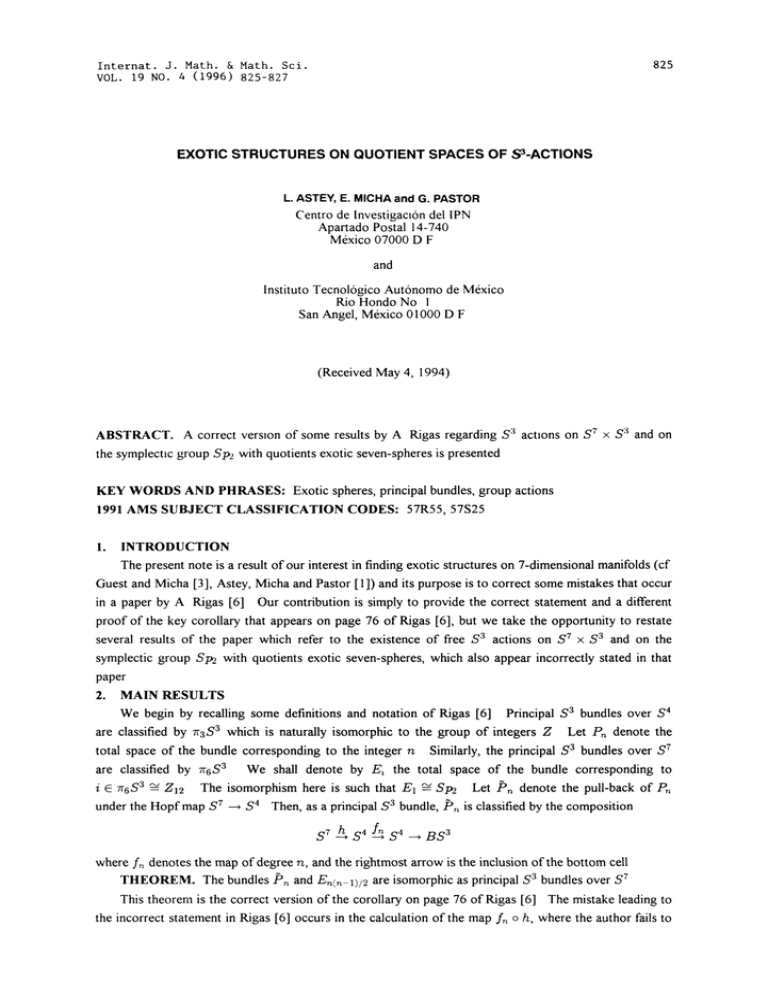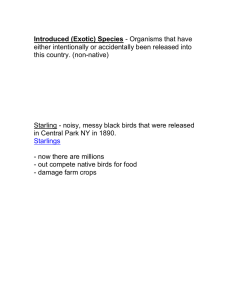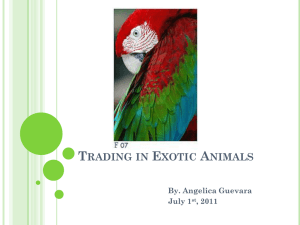EXOTIC STRUCTURES SPACES -ACTIONS
advertisement

Internat. J. Math. & Math. Sci. VOL. 19 NO. 4 (1996) 825-827 825 EXOTIC STRUCTURES ON QUOTIENT SPACES OF -ACTIONS L. ASTEY, E. MICHA and G. PASTOR Centro de Investigac6n del IPN Apartado Postal 14-740 M6xico 07000 D F and Instituto Tecnol6gico Aut6nomo de M6xico Rio Hondo No San Angel, M6xico 01000 D F (Received May 4, 1994) ABSTRACT. A correct version of some results by A Rigas regarding S acnons on S the symplecnc group Sp2 with quotients exotic seven-spheres is presented S and on KEY WORDS AND PHRASES: Exotic spheres, principal bundles, group actions 1991 AMS SUBJECT CLASSIFICATION CODES: 57R55, 57S25 1. INTRODUCTION The present note is a result of our interest in finding exotic structures on 7-dimensional manifolds (cf Guest and Micha [3], Astey, Micha and Pastor ]) and its purpose is to correct some mistakes that occur in a paper by A Rigas [6] Our contribution is simply to provide the correct statement and a different proof of the key corollary that appears on page 76 of Rigas [6], but we take the opportunity to restate S and on the several results of the paper which refer to the existence of free ,5,3 actions on S symplectic group Sp2 with quotients exotic seven-spheres, which also appear incorrectly stated in that paper 2. MAIN RESULTS We begin by recalling some definitions and notation of Rigas [6] Principal S bundles over S are classified by 7r3S which is naturally isomorphic to the group of integers Z Let P denote the total space of the bundle corresponding to the integer n Similarly, the principal S’3 bundles over We shall denote by E the total space of the bundle corresponding to are classified by 7r6S’3 The here is such that E1 RP2 Let /3, denote the pull-back of E 7r6S’3 isomorphism Z19. ’7 S S Then, as a principal S’3 bundle,/, is classified by the composition under the Hopf map s BS fn denotes the map of degree n, and the rightmost arrow is the inclusion of the bottom cell THEOREM. The bundles/5, and E,(,_I)/9. are isomorphic as principal S bundles over S where This theorem is the correct version of the corollary on page 76 of Rigas [6] The mistake leading to the incorrect statement in Rigas [6] occurs in the calculation of the map f, o h, where the author fails to 826 I, A,".;I’I.IY, !., MICIIA ANI)(I IA.NI()R terate correctly a formula of Hlton [4] An alternative proof using a dfferent bundle decomposition s presented n 3 below It follows from the theorem that and the trlwal bundle 5,7 5" are isomorphic only if n _= 0, 1, 9 or 16 mod 24 (a) 5’7 are isomorphic only ifn 2 or 23 mod 24 (b) zh,, and the canomcal bundle 5’p_, In particular, s not a trivial bundle This renders 4 of Rigas [6] invalid The theorem also allows us to recnfiy the statements of two mportant results of Rigas [6] as follows COROLLARY. There exist free acnons of 5" on 5"7 5": wth quotient the exotic seven-spheres of Eells-Kuiper lnvariants 16, 40 and 48 COROLLARY. There exist free actions of S on 5’p_, with quotient the exotic seven-spheres of Eells-Kmper invariants 2, 26, 34 and 42 3. PROOF OF THE THEOREM As s shown in Rgas [6], 5" can be decomposed into two solid ton U 5"x D and V D S such that the restriction of the bundle/5,, to each toms s trivial Moreover, the transition map ,, . Auv S’3 S S s gven by Auv (Z, y) xn l(yx 1)n ly (n 1), xyx-y where the group structure of unit quaternions is understood on S Since the commutator generates 76S (Hilton and Roitberg [5]) and since A factors through S 6, the theorem is a consequence of the following result PROPOSITION. The map A S x 5 5"3 given by A(x, y) x ’- (yx-)- ly- (,- is ( )/2 homotopic to (xyx yWe first prove the following lemma LEMMA. The maps xkyZx ky-Z and (xyx-ly-) kz are homotopic PROOF. Consider the following commutative diagram S xS S S xS S S S6 where a(x,y)- (xk,yl), fl(x,y): xyx-ly -1, 7(X): x kl, p is the projection that collapses the 3skeleton, fkz is a map of degree kl, and w is the generator of 6S 3 But since S is an H-space, o w Therefore, homotopy compositions are biadditive (Whitehead [7], p 479), so w o fk xkylx-ky - oa o (xyx-y-1) kt We now prove the proposition by induction on n Let c xyx-ly -1 If we take k the lemma we obtain xy- x- y cyxy- ix- Hence, c- ycy- (yxy- X- )ycy- y(xy-lx-ly)cy -1 yc -1 cy -1 1, y- c thats, cy Assume nowthat x(yx-1)y c k() Clearly, k(1) 1 But now 1 and in EXOTIC STRUCTURES ON QUOTIENT SPACES OF Sa-ACTIONS 827 - (z,yz-,,y -)yx,,- (yx Cny(xn-1 (yZ-1)n-ly-(n-1))y-1 c’yc(,-)y-1 cn+k(n-1). Therefore, k(n) [2] [3] [4] [5] n + k(n 1), that is, k(n) n(n + 1)/2 This proves the proposition REFERENCES ASTEY, L, MICHA, E and PASTOR, G., Diffeomorphism type of Eschenburg spaces, to appear in Differenttal Geometry and tts Applications. EELLS, J and KUIPER, N., An invariant for certain smooth manifolds, Ann. Mat. Pure Appl. 61} (1962), 93-110 GUEST, M. and MICHA, E, Detecting exotic structures via the Pontrjagin-Thom construction, Mathematika 41 (1994), 145-148. HILTON, P, Suspension theorems and the generalized Hopf Invariant, Proc. London Math. Soc., 3 (1951), 462-492. HILTON, P and ROITBERG, J, On principal S3-bundles over spheres, Ann. Math. 91} (1969), 91107 [6] RIGAS, A., S3-Bundles and exotic actions, Bull. Soc. Math. France 112 (1984), 69-92. [7] WHITEHEAD, G, Elements of Homotopy Theory, Springer-Verlag, 1978.







